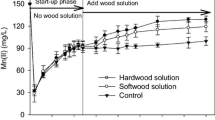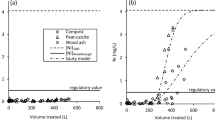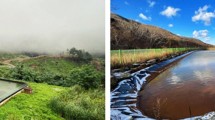Abstract
Four volumes of spent mushroom compost were exposed to synthetic coal mine drainage (pH 3.5, 48 mg L−1 Fe, 22 mg L−1 Mn) under oxidizing conditions (Eh 300 to 400 mV) at a relatively high rate of flow. After 15 days, the compost lost its ability to elevate pH, to lower the redox potential, to lower outlet iron concentrations, and to lower manganese concentrations, with larger volumes retaining more Fe and H+, but less Mn. Estimated retention maxima per liter of spent mushroom compost were 281 μeq H+, 5.56 g Fe, and 0.15 g Mn. These values are similar to those reported elsewhere for peat. The ‘saturated’ compost was then mixed and exposed to mine water in order to eliminate ‘dead zones’ in the compost. Subsequently, the compost was re-exposed to synthetic mine water (pH 4.0, 60 mg L−1 Fe, O mg L−1 Mn) under a much lower flow rate and less oxidizing regime for a period of 114 days. Under the low flow regime, iron was first exported from the compost as reducing conditions were established, and then retained on a stable basis. In addition, Eh was lowered and pH was elevated by the compost. On a net basis, the capacity of the compost to retain iron was increased and apparently stable under the decreased flow conditions.
Similar content being viewed by others
References
Benoit, D. A., Mattson, V. R., and Olson, D. L.: 1982, Water Res. 16, 457.
Dvorak, D. H., Edenborn, H. N., Hedin, R. S., and McIntire, P. E.: 1991, ‘Treatment of Metal-Contaminated Water Using Bacterial Sulfate Reduction: Results from Pilot-Scale Reactors’, in Proceedings of the 1991 National Meeting of the American Society for Surface Mining and Reclamation, Durango, CO.
Gerber, D. W., Burrie, J. E., and Stone, R. W.: 1985, ‘Removal of Dissolved Iron and Manganese Ions by a Spagnum moss’, in R. Brooks, D. Samuel, and J. Hill (eds.), Wetlands and Water Management on Mined Lands, The Pennsylvania State University, University Park, PA.
Gotoh, S. and Patrick, W. H.: 1972, Soil Sci. Soc. Amer. Proc. 36, 738.
Hedin, R. S.: 1989, ‘Treatment of Coal Mine Drainage with Constructed Wetlands’, in S. K. Majumdar, R. P. Brooks, F. J. Brenner, and R. W. Tiner, Jr. (eds.), Wetlands Ecology and Conservation: Emphasis in Pennsylvania, The Pennsylvania Academy of Science, Easton, PA.
Hellier, W. W.: 1989, ‘Constructed Wetlands in Pennsylvania an Overview’, in J. Salley, G. L. McCready, and P. L. Wichlacz (eds.), Biohydrometallurgy, Proceedings of the International Symposium. Jackson Hole, WY.
Henrot, J. and Wieder, R. K.: 1990, J. Environ. Qual. 19, 312.
Kleinmann, R. and Girts, M.: 1987, ‘Acid Mine Water Treatment in Wetlands: An Overview of an Emergent Technology’, in K. Reddy and W. Smith (eds.), Aquatic Plants for Water Treatment and Resource Recovery, Magnolia Publishing Inc., Orlando, FL.
Lohr, V. I., Wang, S. H., and Wolf, J. D.: 1984, HortScience 19, 681.
McIntire, P. and Edenborn, H.: 1990, ‘The Use of Bacterial Sulfate Reduction in the Treatment of Drainage from Coal Mines’, in J. Skousen, J. Sencindiver, and D. Samuel (eds.), Proceedings of the 1990 Mining and Reclamation Conference and Exhibition, Vol. II. West Virginia University, Morgantown, WV.
Patrick, W. H. and Turner, F. T.: 1968, Nature 220, 476.
Stark, L. R.: 1990, ‘A Study of Natural Wetlands Associated with Acid Mine Drainage’, Final Report, Contract No. H0378021, U.S. Department of the Interior, Abandoned Mine Lands Programm, Pittsburgh, PA.
Stark, L. R., Wenerick, W. R., Wuest, P. J., Williams, F. M., and Stevens, S. E., Jr.: 1991, ‘Adding a Carbon Supplement to Simulated Treatment Wetlands Improves Mine Water Quality’, Second International Conference on the Abatement of Acidic Drainage. Montreal, Canada. Vol. 2, pp. 465–483.
Stumm, W. and Morgan, J. J.: 1981, Aquatic Chemistry, 2nd ed. John Wiley & Sons, New York, NY.
Tarutis, W. J., Jr. and Unz, R. F.: 1990, ‘Chemical Diagenesis of Iron and Manganese in Constructed Wetlands Receiving Acidic Mine Drainage’, in P. Cooper and B. Findlater (eds.), Constructed Wetlands in Water Pollution Control, Proceedings of the International Conference on the use of Constructed Wetlands in Water Pollution Control. Pergamon Press, New York, NY.
Wetzel, R. G.: 1983, Limnology, 2nd ed. Saunders College Publishing, New York, NY.
Wieder, R. K.: 1989, Wetlands 9, 299.
Wieder, R. K., Linton, M., and Heston, K.: 1990, Water, Air, and Soil Pollution 51, 181.
Author information
Authors and Affiliations
Rights and permissions
About this article
Cite this article
Stark, L.R., Wenerick, W.R., Williams, F.M. et al. Restoring the capacity of spent mushroom compost to treat coal mine drainage by reducing the inflow rate: A microcosm experiment. Water Air Soil Pollut 75, 405–420 (1994). https://doi.org/10.1007/BF00482949
Accepted:
Issue Date:
DOI: https://doi.org/10.1007/BF00482949




